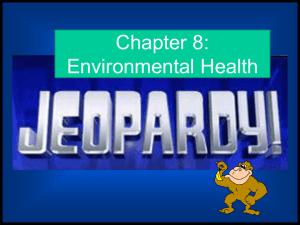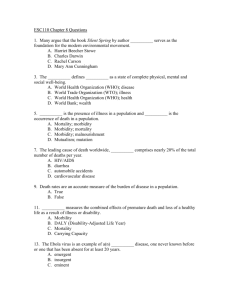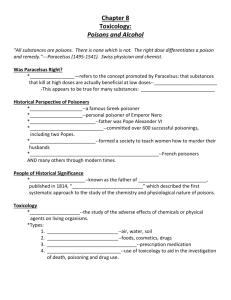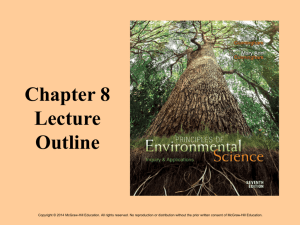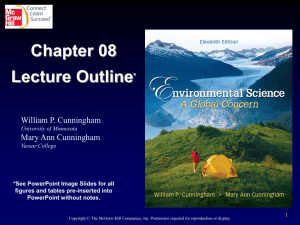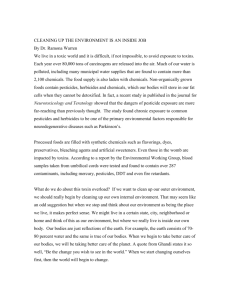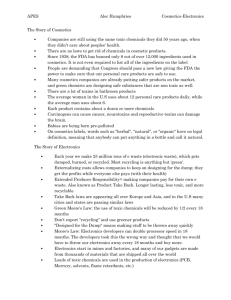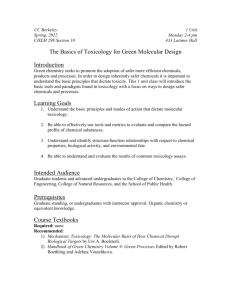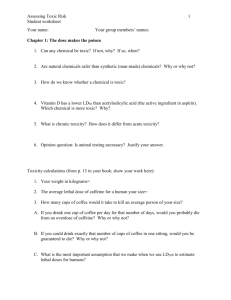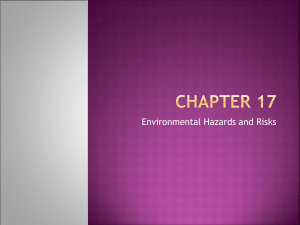chapter 8 Environemntal Health and Toxicology
advertisement
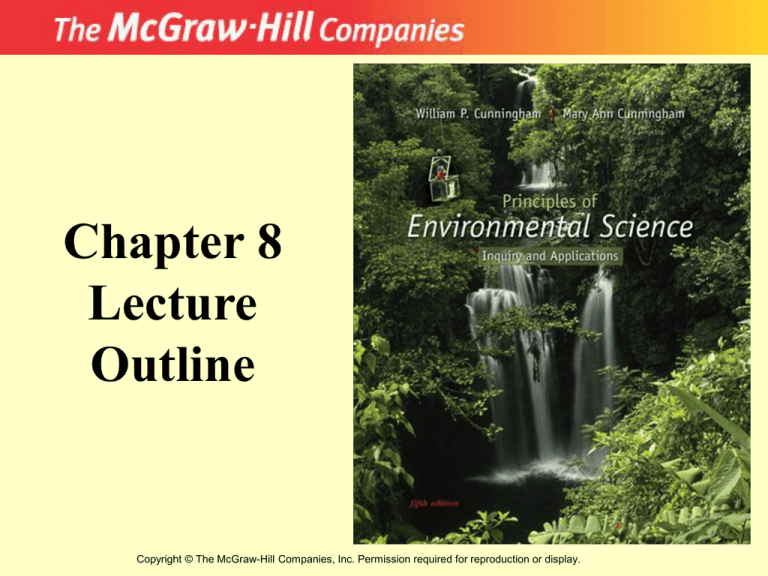
Chapter 8 Lecture Outline Copyright © The McGraw-Hill Companies, Inc. Permission required for reproduction or display. Learning Outcomes After studying this chapter, you should be able to answer the following questions: • What is environmental health? • What health risks should worry us most? • Emergent diseases seem to be more frequent now. What human factors may be involved in this trend? • Are there connections between ecology and our health? • What are toxins, and how do they affect us? • When Paracelsus said, “The dose makes the poison,” what did he mean? • What makes some chemicals dangerous and others harmless? • How much risk is acceptable, and to whom? 8-2 To wish to become well is a part of becoming well. –Seneca 8-3 8.1 Environmental Health • Health is a state of complete physical, mental, and social wellbeing, not merely the absence of disease or infirmity. • A disease is an abnormal change in the body’s condition that impairs important physical or psychological functions. • Morbidity means illness. • Mortality means death. • Environmental health focuses on factors that cause disease, including elements of the natural, social, cultural, and technological worlds in which we live. 8-4 Major sources of environmental health risks 8-5 Emergent and infectious diseases still kill millions of people • Emergent diseases are those not previously known or that have been absent for at least 20 years. 8-6 8-7 Pathogens are disease-causing organisms • The greatest loss of life from an individual disease in a single year was the great influenza pandemic of 1918. 8-8 Outbreaks of infectious dieseases 8-9 The spread of West Nile virus • West Nile virus shows how fast new diseases can travel. • West Nile belongs to a family of mosquitotransmitted viruses that cause encephalitis (brain inflammation). 8-10 Resistance to antibiotics and pesticides is increasing • In recent years, health workers have become increasingly alarmed about the rapid spread of methicillin-resistant Staphylococcus aureus (MRSA). • Malaria, whose vector is mosquitoes and is caused by a protozoan, now claims about 2 million lives every year—90 percent in Africa, and most of them children. 8-11 How microbes acquire antibiotic resistance 8-12 Why the U.S. should pay more for world healthcare • WHO estimates that 90 percent of all disease burden occurs in developing countries. • Wealthy nations pursue drugs to treat baldness and obesity, depression in dogs, and erectile dysfunction. • Billions of people in other nations are sick or dying from treatable infections and parasitic diseases. 8-13 8.2 Toxicology • Toxicology is the study of toxins (poisons) and their effects, particularly on living systems. • Environmental toxicology, or ecotoxicology, specifically deals with: – the interactions, – transformation, – fate, and – effects of natural and synthetic chemicals in the biosphere, including individual organisms, populations, and whole ecosystems. 8-14 Top 20 toxic and hazardous substances 8-15 How do toxins affect us? • Allergens are substances that activate the immune system. • Some allergens act directly as antigens. • Antigens are substances (pollen, bacteria, etc.) recognized as foreign by white blood cells and stimulate the production of specific antibodies. • Antibodies are proteins produced by our bodies that recognize and bind to foreign cells or chemicals. 8-16 Sick Buildings • Sick building syndrome: headaches, allergies, and chronic fatigue caused by poorly vented indoor air contaminated by various contaminants. 8-17 Classes of Harmful Agents • Neurotoxins are a special class of metabolic poisons that specifically attack nerve cells (neurons). • Mutagens are agents, such as chemicals and radiation, that damage or alter genetic material (DNA) in cells. • Teratogens are chemicals or other factors that specifically cause abnormalities during embryonic growth and development. • Carcinogens are substances that cause cancer. 8-18 8-19 8.3 Movement, Distribution, and Fate of Toxins • Factors affecting toxicity: – dose (amount) – route of entry – timing of exposure – sensitivity of the organism 8-20 Solubility and mobility determine when and where chemicals move • Chemicals can be divided into two major groups: – Water soluble compounds move rapidly and widely through the environment because water is ubiquitous. – Molecules that are oil- or fat-soluble (usually organic molecules) generally need a carrier to move through the environment and into or within the body. 8-21 Exposure and susceptibility determine how we respond 8-22 Bioaccumulation and biomagnification increase chemical concentrations • Biomagnification occurs when the toxic burden of a large number of organisms at a lower trophic level is accumulated and concentrated by a predator in a higher trophic level. 8-23 Persistence makes some materials a greater threat • Many substances degrade when exposed to sun, air, and water. • This can destroy toxins or convert them to inactive forms. • But some materials are persistent and can last for years or even centuries as they cycle through ecosystems. • Examples: – Heavy metals: lead and mercury. – Many organic compounds, such as PVC plastics and chlorinated hydrocarbon pesticides. 8-24 8.4 Mechanisms for Minimizing Toxic Effects • Each of us consumes lethal doses of many chemicals over the course of a lifetime. • One hundred cups of strong coffee, for instance, contain a lethal dose of caffeine. • Similarly, 100 aspirin tablets, 10 kg (22 lbs) of spinach or rhubarb, or a liter of alcohol would be deadly if consumed all at once. 8-25 8.4 Mechanisms for Minimizing Toxic Effects • Metabolic degradation and excretion eliminate toxins – Most organisms have enzymes that process waste products and environmental poisons to reduce their toxicity. • Repair mechanisms mend damage – Tissues and organs that are exposed regularly to physical wear-and-tear or to toxic or hazardous materials often have mechanisms for damage repair. 8-26 8.5 Measuring Toxicity • A convenient way to describe toxicity of a chemical is to determine the dose to which 50 percent of the test population is sensitive. • In the case of a lethal dose (LD), this is called the LD50. • Acute effects are caused by a single exposure to the toxin and result in an immediate health crisis. • Chronic effects are long-lasting, perhaps even permanent. 8-27 8.6 Risk Assessment and Acceptance 8-28 8.7 Establishing Public Policy 8-29 Practice Quiz 1. Define the terms health and disease. 2. Name the five leading causes of global disease burden expected by 2020. 3. Define emergent diseases and give some recent examples. 4. What is conservation medicine? 5. What is the difference between toxic and hazardous? Give some examples of materials in each category. 6. What are endocrine disrupters, and why are they of concern? 7. What are bioaccumulation and biomagnification? 8. Why is atrazine a concern? 9. What is an LD50? 10. Distinguish between acute and chronic toxicity. 8-30
